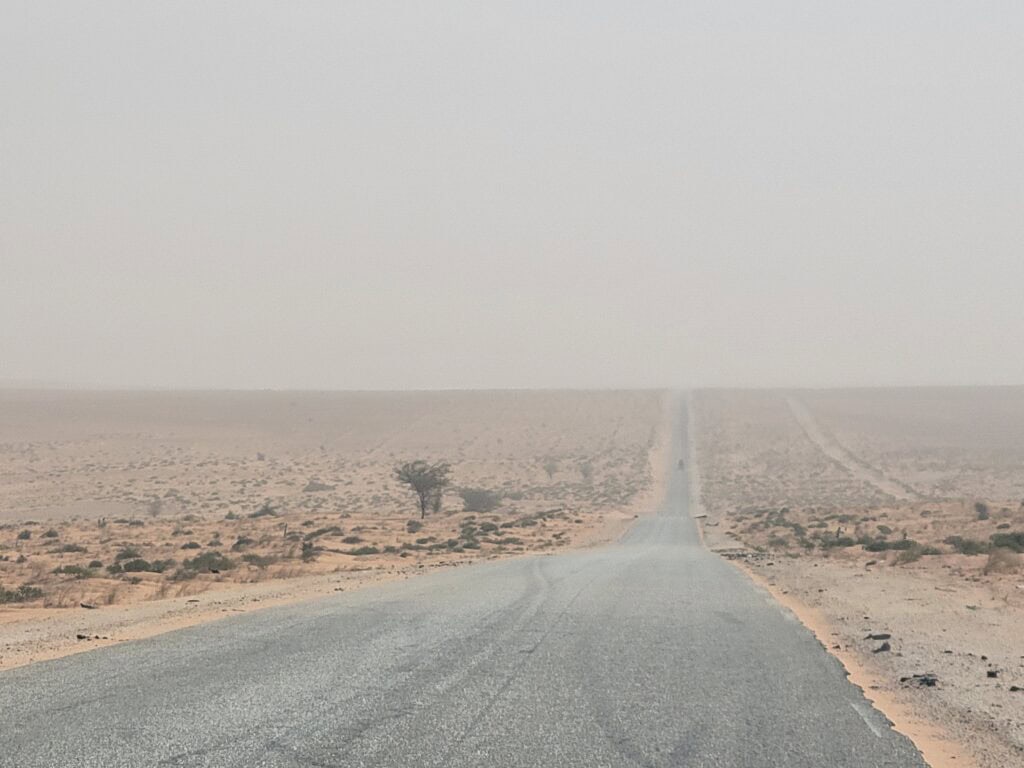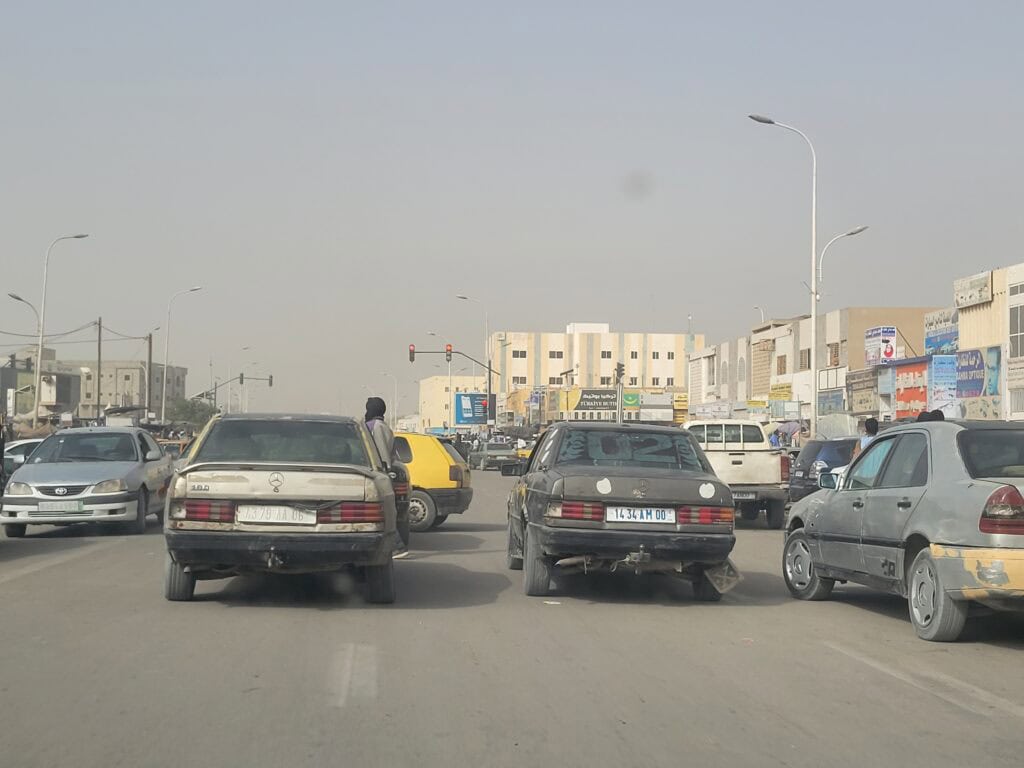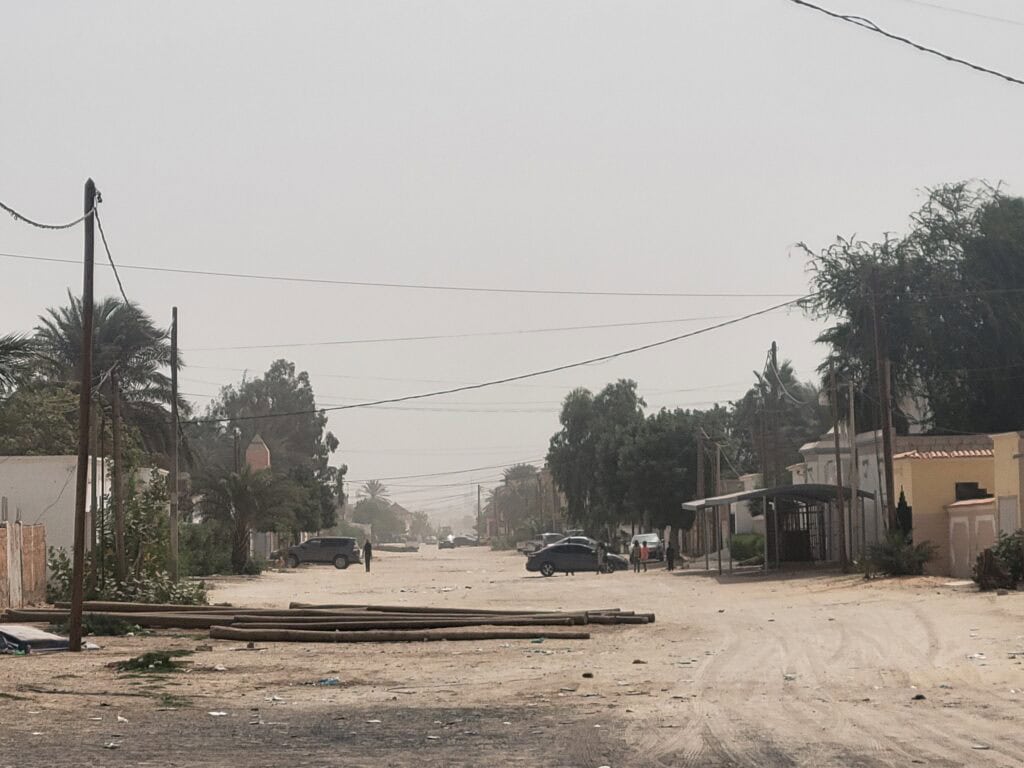Want to know what it’s like travelling in Mauritania? Or if you will feel welcome? ‘Mauritania – Useful Information for Travellers’ is our personal experience exploring this country in 2024. Our adventure includes Nouadhibou and Nouakchott. We share our insights on where to stay, where to eat and drink, and things to see and do. ‘Mauritania – Useful Information for Travellers’ reflects our travel style and aims to provide useful things to know before visiting this obscure destination.
Mauritania, ‘the land of a thousand poets’. Mauritanians are proud of their traditions and their culture. They are willing to talk with you and share their stories with you. With 2/3 of the country covered by desert, and ranked among the poorest countries in the world, you might expect the people to be a little downhearted, but this is far from what we found. We found people to be welcoming, resilient and content. Is it a place for the beginner? Not really. Is it a country that will be on every one’s bucket list? Probably not. But with access and organised tours becoming more popular, it’s becoming an easier destination for the curious and intrepid travellers.
Why go to Mauritania?
With some of the best unspoilt sand dunes on the planet, and the magnificent Saharan Desert, Mauritania offers experiences that you won’t find anywhere else. The longest train in the world is one of the main drawcards, and trips to the ‘Eye of the Sahara’ are now becoming possible and attracting the attention of explorers. The people and their culture are interesting and a rewarding experience that you will never forget. Nouadhibou and Nouakchott are fascinating cities that are truly out of this world. Mauritania. Come here because it’s different. What you will find is unique landscapes, warm people, and the unusual.
- Capital: Nouakchott
- Best time to visit: November-March (when it’s the coolest)
- Budget/Mid-Range/Couple: AU$100 per day
- Currency: Mauritanian Ouguiya (UM25 = AU$1)
- Language: Arabic
- Visa: Yes
- Difficulty: 4 (1-basic & 5-challenging)

Nouadhibou
Nouadhibou is a strange place. It’s a bit like a lawless town in a Western movie. It’s the main starting point for trips into the desert, or on the Iron Ore Train. There’s not a late model car in sight, with the roads full of ancient beat-up wrecks of cars that you would only find at the scrap dealer back home. Here, if the car runs, it’s fit for the road, but this is part of the charm. Different trades gather together on the same street to sell their items, groups of welders, metal supplies, cement, spare parts, common goods that you’d need to live here. There’s no flash signs or bright lights here. It’s simple items to survive in this climate. After a day spent crossing the border, Nouadhibou was a welcome stop for us. At first the town may appear a little dismal and run down. However, there’s a comfort around, a safety. People are relaxed, accepting, curious and helpful. It is a welcoming place to refresh before you head off into the desert wilderness again.
Getting to Nouadhibou
There are public taxis and vans that travel from the border to Nouadhibou, a one hour drive. The road isn’t in a great condition. There are numerous police checkpoints. The officers are friendly, and are just there to ensure everyone’s safety, so be polite, follow instructions, and you will soon be on your way. Driving from Nouakchott takes six hours or so depending on the conditions.
Where to stay in Nouadhibou
We stayed at Nouadhibou Guesthouse, and highly recommend it. It was an oasis! It is run by two Australians from Perth who know how to make you feel comfortable. AU$55 per night including a lovely breakfast delivered to your room. It’s one of the best spots to stay in the city. Ricardo was a great host whatsapp+22231072966. There are limited options around town, with Villa Maguela another popular resting spot.
Where to eat and drink in Nouadhibou
You’ll find fresh bread and coffee easily, but forget about other items from home. Downtown, the grocery store has enough basic supplies to self-cater (including pasta, olive oil, nuts and dates). Additionally, the fruit and vegetable market is limited, but has enough variety to make a nice meal. Fruit is the most limited and expensive here.
- Get to Galloufa Spanish Restaurant (Lovely homemade meals. It had no sign when we visited. At the bottom of town. Ask your accommodation or locals for directions)
- Don’t miss November 24 Supermarket (the best selection of supplies and they also change money here)
Things to see and do in Nouadhibou
Walk downtown and experience local life Find the grocery store, stop at a street vendor to buy fruit or nuts, grab some dinner at a local restaurant. Immersing yourself and interacting with the locals is what will make your stay enjoyable. A wonderful mix of culture and religion, the traditional Mauritania dress of the men is a standout. Plus, you will most likely pass goats rummaging through rubbish piles, cows wandering freely, or donkeys waiting patiently with their carts.
Jump in a taxi and enjoy the ride!
The Port Head down to the port for some nice photos (if there is visibility!).
Seal Colony There is a seal colony out on the point, but you will need to talk to the coast guard to get access. Again, this will depend on visibility too!
Getting around Nouadhibou
Cars will stop and offer you a lift when you are walking. Taxis are a popular choice to get around. The centre of town can be negotiated on foot.

Nouakchott
The capital of Mauritania, Nouakchott is a bit more orderly than other parts of the country. The style of the people here is eye catching, especially on a Sunday. The styles reflect the amazing mix of people, culture and religion. Its busy, chaotic and dusty, but it somehow works. People are strong and focused, many are here to work hard and reach their goals. Additionally, it is a great place to get any repairs done to your car if you are driving. Ultimately, it’s the only place in the country to stock up on any items you need, organise any excursions, or enjoy a few days at a nice hotel or guesthouse. Once you leave Nouakchott, things get remote very quickly.
There’s a Senegalese Embassy if you need a visa before heading South. If you are heading to the border crossing at Diama, and you require a visa, they no longer issue visas at the border. You must get your visa beforehand.
Getting to Nouakchott
The drive from Nouadhibou to Nouakchott takes seven hours. There were twelve checkpoints, limited petrol stations, and sections of terrible road, so allow time, bring fuel, and pack water and food. From Nouakchott to the border crossing into Senegal at Diama took us five hours, with the last two hours of the trip being on a potholed, bumpy and dusty dirt track. Once you pass through customs, the drive to St Louis is only thirty minutes. No visas are issued at this border. You must already have a visa if you require one.
Nouakchott is reachable by air from Paris, Istanbul and a handful of other African destinations. The quickest and simplest way would be to fly. If you are driving, entering from Senegal is the shortest route.
Where to stay in Nouakchott
The city has numerous places to stay, to suit most budgets. We stayed at a guesthouse near the centre AU$70 double, including breakfast, which was bread, pastries, jam and coffee. Most places offer free secure parking, a restaurant, or even a pool. An easily reached comfortable room with a cold shower will offer the relief you need after hot and dusty outings.
Where to eat and drink in Nouakchott
Nouakchott has a wider variety of restaurants around, including French and Indian. Some hotels and guesthouses have restaurants too.
- Don’t miss The India Gate (delicious vegetarian and vegan dishes, the staff are friendly and happy to answer questions)
- Get to Paul Boulangerie (freshly baked breads and pastries)
- Check out Big Market (Best selection of fruit, vegetables and Western staples)
Things to see and do in Nouakchott
Immerse yourself Walk, drive or take a taxi ride to see the city in action, this is priceless. The unbeatable style, strength and resourcefulness of these people is amazing. Walk anywhere close enough, to the bakery for a coffee and pastry, to the supermarket for supplies, to a restaurant for lunch. Get amongst the action.
Saturday Market A melting pot of activity and is definitely worth a visit.
National Museum of Mauritania When we went, it was closed.
Port de Peche Head down early to see the fishermen return. Allow time, it’s very hectic, be friendly and patient, some of the fisherman will engage in friendly banter.
Grand mosque A popular sight.
The Desert Mauritania has two National Parks, Banc d’arguin and Diawling National Park. These contain large numbers of different species of birds. Both parks can only be visited with a guide. Dahid at Agence Levrigue provides excellent tours [email protected]. There’s no fixed cost. You will need to negotiate a price. Expect to pay AU$200 for a day trip. It’s also possible to camp overnight in the park. The parks aren’t filled with wildlife. During our trip to Mauritania, we saw camels, warthogs and lots of birds. Gazelles, monkeys, hyenas and scorpions also call Mauritania home.
Getting around Nouakchott
Taxi is the easiest and most relaxing way to get around. Driving is a challenge, especially if you aren’t used to the way things work. Short walks to cafes, shops and restaurants make exploring the city more comfortable, as the streets are sandy and dusty. It’s also hot, so walking long distances isn’t really an option.

Getting to Mauritania
We experienced Mauritania in 2024, while participating in the Dakar Challenge. This enabled us to travel by car, which is really the only way to travel around the country. Apart from local taxis that operate in the two cities, long distant public transport is pretty much non-existent. Border crossings are far from easy, but visas are issued at the border.
We drove down through Morocco and Western Sahara, and entered at the land border near Gueruerat, Western Sahara. We had the help of a local fixer, which made the process much easier. It is still painfully slow. There are no toilets or services at the border. Your passport will be taken for an hour or so, but it will come back eventually. It’s possible to cross unassisted on your own, but you would want to be able to speak some Arabic and French, and to have some experience crossing remote land borders.
Once you are in the country, organising transport or tours is possible, but it would take days before you were ready to depart. Large parts of the East are off limits. Trips into the desert or on the Iron Ore Train are best prepared well in advance. It’s a cash society, so bring plenty with you to cover any planned expenditure. Including Mauritania in an overland trip or with a visit to a neighbouring country worked well for us, and having your own transport is a definite bonus.
Entering Mauritania from Senegal, in the South, would be the quickest and simplest way if you were travelling overland by car. You would need your own car, as hire companies do not permit entry into Mauritania with a hire vehicle.
Visa Requirements for Mauritania Required by almost everyone. These are available at land borders and on arrival at Nouakchott International Airport. We paid AU$90/EURO55. You must have the correct change, as no change will be given. Obtaining your visa before departure would be a good idea, if you have access to a Mauritanian embassy.
Useful things to know before visiting Mauritania
People don’t like photos taken, very sensitive and can wave their finger at you in disapproval.
It’s hot and dusty. Bring some good shampoo.
There are sandstorms and this can affect air quality and visibility for long periods.
A protective pouch for your mobile phone is a good idea to keep the sand out.
Some of the roads are in terrible condition.
There’s not a huge variety of fruit and vegetables.
Children will run up to you to ask for money or gifts.
People are friendly and happy to help.
You won’t see many other traveller’s, your mobile phone won’t work and there is no e-sim either.
Modern conveniences you will not find, tourist information centres either.
Bring cash. Paying by card is rare.
Not a lot of English spoken, but we found if someone did speak English, they enjoyed an opportunity to practise and share their story. Take a moment to ask them some questions, it’s the best way to learn about life here.
Final thoughts on travelling in Mauritania
Mauritania is its people, and seeing them go about their day to day life is something we won’t forget. It’s a tough existence here, but they somehow manage to do it day after day, with a smile on their face. Travelling here isn’t easy, far from it. But if you are after a new experience, something different and unique, without all the tourists, then it’s a destination for you. There’s a lot of driving involved to get around, but these were our favourite days. The harshness of the desert and the remote location gave it a raw beauty like nowhere else. To see the people living in that environment is incredible, and worth the journey. Don’t come here for gourmet food and five-star hotels, come to support the people and appreciate how resilient they are.
